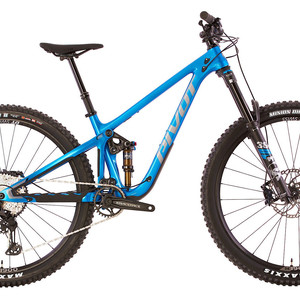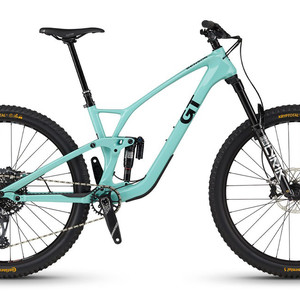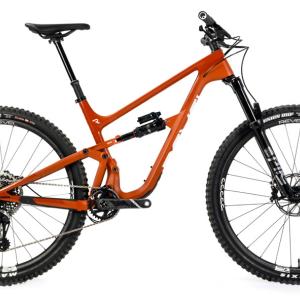2013 Santa Cruz Tallboy LT Carbon
(discontinued)
| Where To Buy | |||
|---|---|---|---|
Free shipping on orders over $50 (continental U.S. only).
International shipping available. Some exclusions apply. |
|||
Free shipping on orders over $50 (continental U.S. only).
International shipping available. Some exclusions apply. |
|||
Reviewed by Matt Thompson and Jess Pedersen // Written by Brandon Turman // Photos by Shawn Spomer and Brandon Turman
The Santa Cruz Tallboy LT was released on April Fools Day, 2012. It's no laughing matter though. In fact, this long travel 29er is capable of taming the most serious descents. It does however, know have to have fun, and lots of it.
The original Tallboy, introduced about four years ago, was among the first 29ers that people actually enjoyed riding. But the people wanted more - more travel, slacker angles, more fun. After weighing their options, seeing what worked well and what didn't, the boys at Santa Cruz unleashed this beauty. The Tallboy LT comes in both aluminum and carbon flavors, and features 135mm of VPP2 (Virtual Pivot Point) driven suspension. For our 2013 Test Sessions in Southern Utah, we chose to go all out with the carbon frame - the Tallboy LTc.

Tallboy LTc Highlights
- Carbon fiber, 5.18-pound frame weight
- 29-inch wheels
- 135mm (5.3-inches) of rear wheel travel
- 130-150mm fork options (140mm stock)
- Tapered head tube
- 69.5-degree head angle
- 72.6-degree seat tube angle
- 13.4-inch bottom bracket height
- 17.9-inch chainstay length
- 73mm threaded bottom bracket shell with ISCG05 tabs
- 142x12 rear thru-axle
- MSRP $4665-$9465 depending on build kit, or $2698 for frame + shock only
Rather than simply tweaking a few angles and slightly modifying the original Tallboy, Santa Cruz went back to the drawing board when designing the Tallboy LT, resulting in a very much improved frameset for the aggressive trail/all-mount rider. The all-new frame features a tapered headtube, ISCG05 chainguide tabs, downtube mounted shock, threaded bottom bracket, clamp-on front derailleur, rubberized downtube and chainstay guards, metal chainstay guard, and was the first Santa Cruz to use a 12x142mm through axle, complete with a replaceable threaded insert. There's also the option of running Shimano's new direct-mount derailleur standard.

All of those improvements would likely be overlooked if the frame wasn't sufficiently stiff, though, which is why the crew beefed up the non-driveside carbon chainstay to seatstay strut. It was also moved forward in order to directly connect the lower and upper links. The upper pivot area was given some additional love as well, and by wrapping the carbon in a new way, the rear end saw an additional stiffness increase.
Speaking of carbon, that's one of the big things Santa Cruz prides themselves on, and for good reason. They don't name it anything fancy, they just do it damn well. There are three (well, three they can talk about) ways that their carbon stands out:
1) One piece lay-up and curing - By laying up and curing the front triangle all at the same time, and not assembling together pieces, we're able to decrease the amount of material used by eliminating overlapping joints that have to be bonded or wrapped with carbon. Less material means fewer grams. This method is extremely expensive to do, since each size has to have a lot of dedicated tooling, nothing is shared between each size.
2) Continuing fibers around tube junctions - The one-piece lay-up of the front triangle allows continuous fibers to be used that wrap between tubes, allowing the structure to distribute loads better, and absorb impact energy. We also are able to truly integrate the shock mounts, pivot mounts, dropouts and disc brake tabs into the structure, using all uni-directional carbon plies. The shock mount isn't merely riveted or bonded on after curing, but an integrated part of the fiber lay-up. This makes our carbon frames incredibly strong and able to absorb impact better than any other frames we've tested.
3) Net shape lay-up and fiber compaction - Our lay-up process allow us to control the outside shape, inside shape, and to compact the fiber layers during the lay-up. This eliminates gaps between layers, and keeps resin from migrating to the inside of the tubes, or allowing delamination during the molding process. You can't see this without getting inside the frame, but we're more proud of how the inside of these frames look than the outside. No gaps, no filler or mystery material. No resin pools or glued together sections. It's a frame you wouldn't be embarrassed to bring home to mom. No skeletons in the closet, and no rider weight limits either.
The ultimate result is one drop dead sexy frame that you can rely on. Sounds like a good match, doesn't it?

Out back, the bike relies on the VPP2 suspension system to soak up the hits and provide traction. It uses a pair of super short, counter-rotating links with large diameter axles and angular contact bearings to keep things stiff. The upper link is carbon fiber and the forged aluminum lower link, which has been offset to allow for a chainguide, uses the same grease ports, seals, and locking collet axle hardware that Santa Cruz owners have come to love due to its ease of maintenance. You might notice that the lower link is quite low in relation to the chainring, which may present a clearance issue in extremely rocky, jagged situations.
The VPP2 system on the Tallboy LTc has been tuned to be slightly regressive initially before getting progressive for the last two thirds of the the stroke. This creates a bike that is responsive to small and medium-sized bumps with plenty of support for bigger hits. The FOX CTD Float shock is in a very good position for adjusting the knobs at a moments notice, even though we tended to stay in the 'Trail' mode for the majority of our ride time.
On The Trail
When someone says "long travel 29er," what types of trails come to mind as being a good fit? We thought it best to rally the yellow beast around St. George's Zen Trail. It's rough, techy in spots, fast in others, and has a ton of variety, so it was Jess's pick. To add to the stakes, Matt also took it for a few hot laps down the jump and drop-filled Barrel Ride Trail. We should also mention that Matt owns and rides this bike often outside of our little Test Sessions adventure. If we had had time, a jaunt down the super rough and rugged Grafton Mesa Trail was also due, and based on what the guys experienced, the bike would've performed A-okay over the harsher terrain.
To really get a feel for what the bike was capable of, we immediate swapped out the stem and bars for a slightly shorter and wider setup. The stock setup wasn't bad, this was just better for our tastes. Even before the swap, we did notice that the top tube on our Large test frame was a little on the short side, so consider sizing up. Note that while Santa Cruz does not make the Tallboy LT in anything smaller than a Medium frame size, because their sizing runs a little small, riders as short as 5-foot 5-inches should be able to get along with the bike well.
New bars and stem in place, rider position was good and neutral, allowing the bike to climb comfortably and be playful at the same time. We appreciated the 13.4-inch bottom bracket height, which is on the lower half of the spectrum. At 69.5-degrees, we'd like to tinker with a slacker head-angle for when things get really steep, but the Tallboy LT doesn't need to be much slacker - maybe a half degree or so - but only because it'll lead you into some harry stuff you otherwise wouldn't try. We dug the relatively low stand over afforded by the downward swooping top tube, and the 17.9-inch chainstays gave good stability all around.

Aimed downhill, the Tallboy LT really shined, and we loved to descend this bike. Thanks to being stiff in all the right places, the way it responded to being thrashed was flat out confidence inspiring, and it rarely stepped out of line. Trail speed was remarkable, as was control across the board. Let off the brakes and moments later you'll be hauling ass without even realizing it. It could be ridden casually or through slow techy bits without getting into trouble, but really liked to be pushed.
Simply judging the bike by its numbers is a mistake, because it's far more capable than you'd think. Many 29ers suffer from a somewhat slow, unresponsive steering but the Tallboy wasn't phased. It could be ridden through a corner at speed or by pressing and snapping out of turns, and we had a hoot drifting the bike in mid to long-radius turns. It was responsive and changed lines easily, but provided stability when needed. At times it was hard to get the front end up because of how low the bottom bracket is relative to the axles, in addition to the chainstay length, but we learned to compensate quickly. At the time, it was as playful as any big wheel bike could be.
We really appreciated the way the Tallboy LT ramped up as it went through the travel. As a result, it begged to be ridden hard and pedaled great in the bigger rings - nice and active. It tracked well through the turns with a nice, firm feeling mid-stroke. The rear end soaked up everything we threw at it, pretty much, from drops to jumps to g-outs. The more we pushed into it, the better trail feedback we got. The feedback provided by the VPP system to the feet lets you know exactly where you are, which many aggressive riders will appreciate. Others may find it a little harsh over small bumps and quick hits.

At right around 29-pounds, the perceived weight of our build on the trail was less than it actually was, and the bike felt pretty light once up to speed. Out of the saddle efforts were perhaps a bit sluggish due to the 29-inch wagon wheels, but it felt stiff and responsive under hard efforts, and we noticed very little pedal bob. Hammering on the pedals brought us up to speed quickly, and the bike maintained that speed far better than most 26-inch equivalents.
The rear end stayed planted and driving during seated climbs, and combined with a front end that didn't wander, the bike was a great climber. The only fault we could identify while climbing was the performance in the front granny ring while navigating techy stuff, although we try to stay out of that ring most of the time anyway. Overall, it didn't feel like the suspension was robbing any pedal power and the weight of the bike didn't have a negative effect on the climb. The body position also kept us comfortable throughout extended climbs.
Build Kit
As is usual when purchasing a Santa Cruz, you have the option of purchasing the frame only or selecting one of several build kits. Our 'SPXam' build fell in the $5,900 range and was highlighted by FOX CTD Float Kashima bits front and rear, Shimano XT drivetrain and brakes, tubeless compatible WTB Frequency i23 rims laced to DT Swiss hubs, Maxxis Ardent tires, and a Thomson post.

Save the desire for a dropper post, a few millimeters on the bars, a beefier front tire, and slightly stiffer wheels, we were very pleased with the component spec. Everything worked well, as it should at that price tag. The optional upgrade to ENVE wheels, which will put a huge hole in your wallet, will make the bike turn even better.
As we found in most of the other Test Session reviews, Shimano's XT brakes and drivetrain worked very well. There was plenty of power, great modulation, no fade whatsoever, and they weren't too grabby. The levers were also the perfect length and bend, making them super comfortable. We never once had to think about the drivetrain as it shifted up and down perfectly front and back. Noise wasn't an issue either thanks to the clutched derailleur and built-in chainstay protector. The only noise were able to discern was the cable chatter, simply because the rest of the bike was so quiet.
The Maxxis Ardent tires were impressive when it came to flat out rolling speed, although after several front end pushes in various conditions we'd definitely go with something a little meatier up front.
Long Term Durability
You've read about the carbon technology, and you've probably seen the jaw-dropping videos demonstrating the strength of carbon Santa Cruz frames. Add to that a five year frame warranty and lifetime pivot/bearing warranty and there's nothing to worry about, except which trail you want to tame next.

What's The Bottom Line?
Clean lines, refined VPP suspension, attention to detail, build kit choices, and that distinctive scuba yellow color… what's not to love? The Santa Cruz Tallboy LTc rips. Push it hard and take chances. Rally it like a downhill bike on the way down, then point it straight back up for another lap. It'll keep up. There isn't one area where the bike doesn't perform well, and it excels in many others. This is a great, dependable, and responsive all around bike that is perfect for, well, just about anyone, especially if you enjoy having fun.
Hop on over to www.santacruzbikes.com for more info.
Bonus Gallery: 42 photos of the 2013 Santa Cruz Tallboy LTc
About The Reviewers
Matt Thompson - Humble enough not to claim his Master's Downhill World Champ status when we asked him what his accomplishments were, Matt has over 20 years on a bike and likes to go fast. Really fast. At 210 pounds of trail building muscle, he can put the hurt on a bike in little to no time.
Jess Pedersen - Jess is one of those guys that can hop on a bike after a snowy winter and instantly kill it. He's deceptively quick, smooth, and always has good style. He's also known to tinker with bikes 'til they're perfect, creating custom additions and fixes along the way. Maybe it's that engineering background...
Specifications
Prices and build kits vary. Visit www.santacruzbikes.com for complete details.
| Where To Buy | |||
|---|---|---|---|
Free shipping on orders over $50 (continental U.S. only).
International shipping available. Some exclusions apply. |
|||
Free shipping on orders over $50 (continental U.S. only).
International shipping available. Some exclusions apply. |
|||






























2 comments
Post a reply to: 2013 Test Sessions: Santa Cruz Tallboy LTc